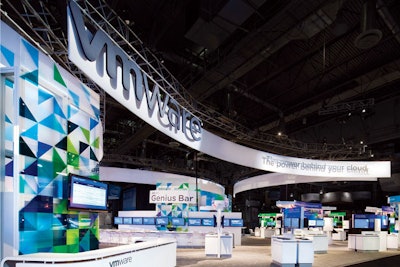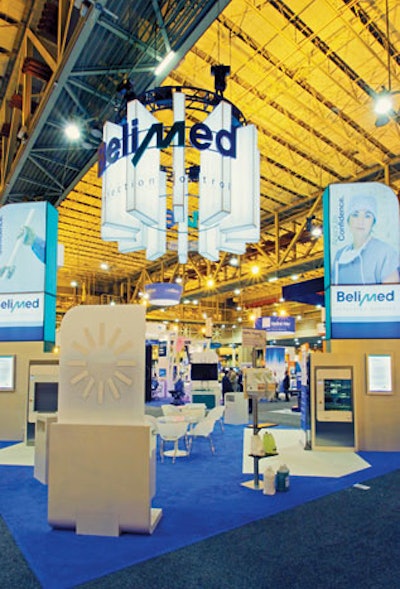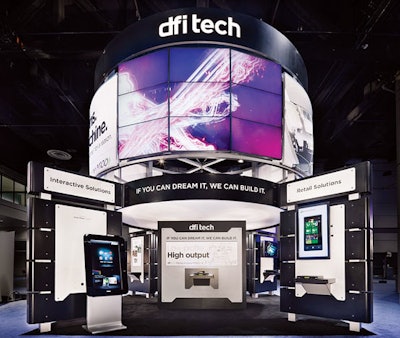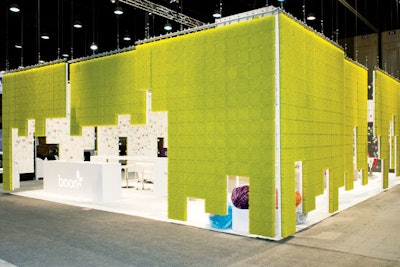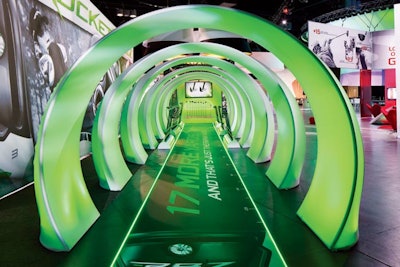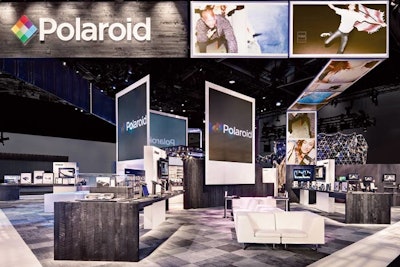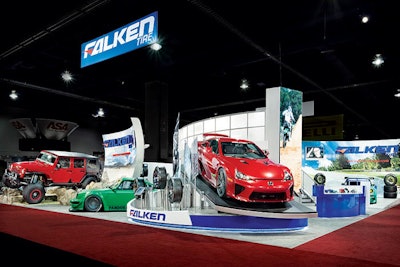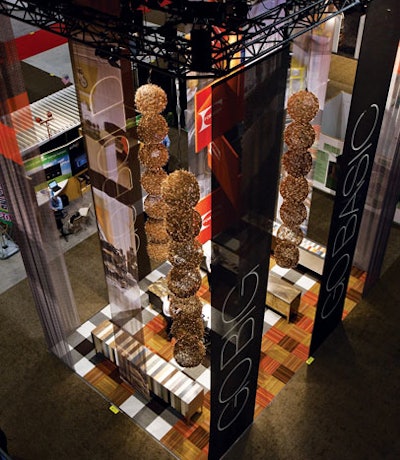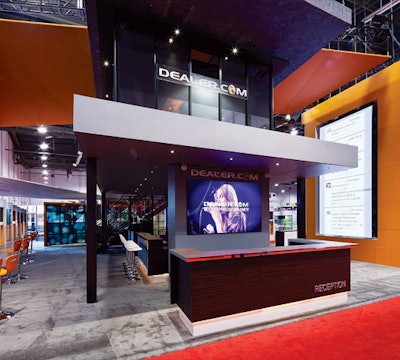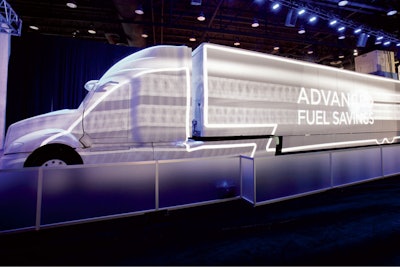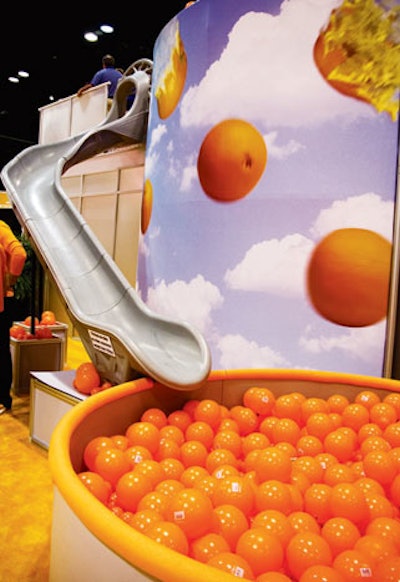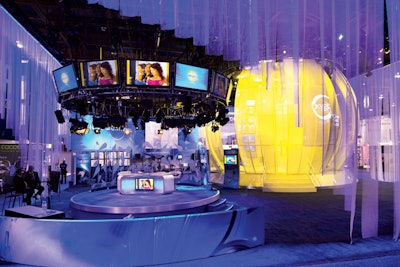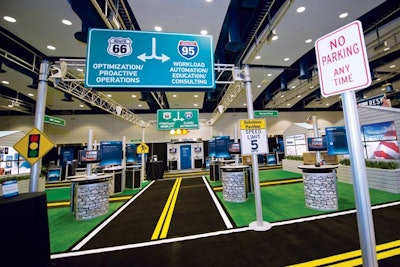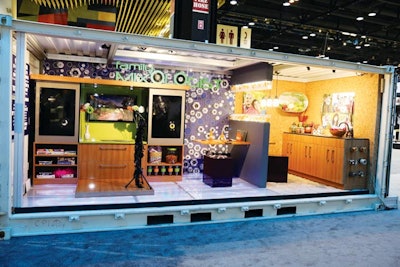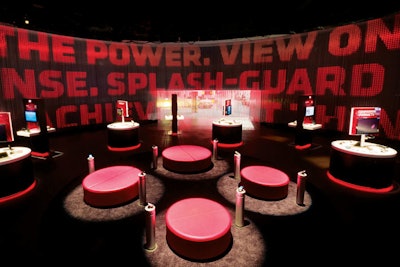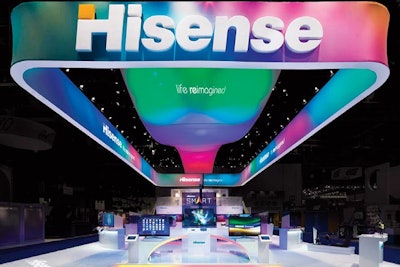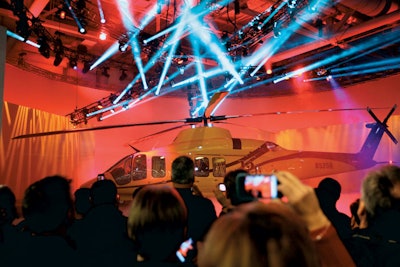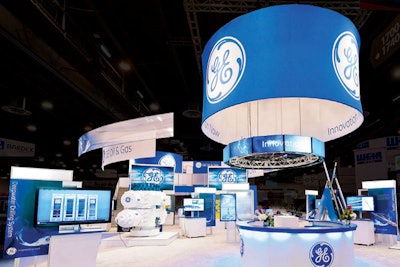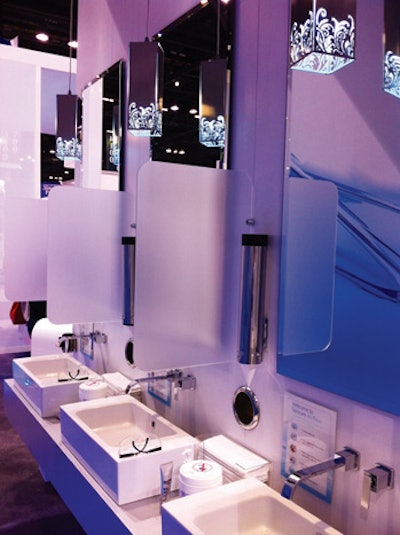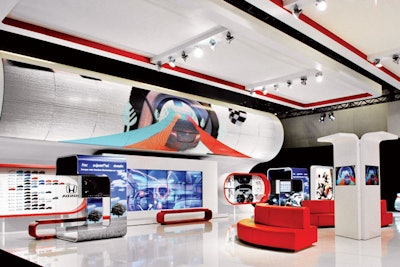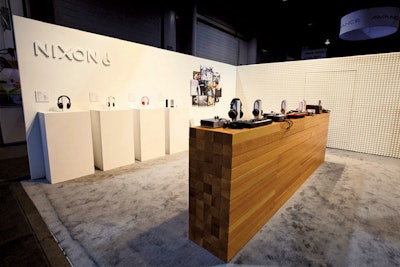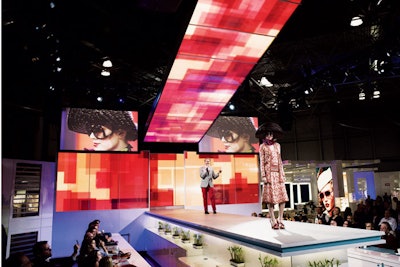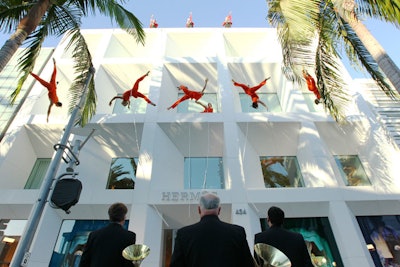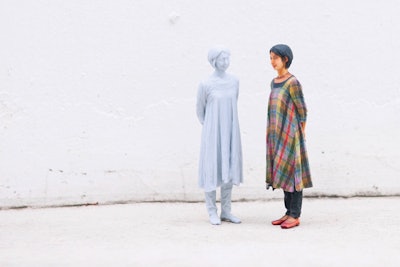
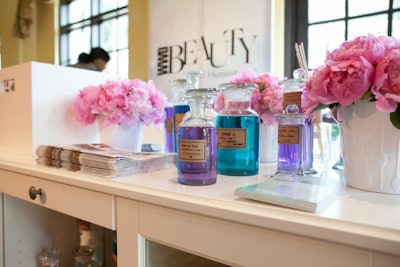
At the WWD Beauty C.E.O. Summit in 2012 at the Breakers Palm Beach in Florida, the apothecary-inspired registration desk held different-sized jars filled with colored liquids, cotton balls, and Q-tips. Pink peonies in white vases, bright-colored towels, diffusers, and WWD magazine issues also adorned the desk.
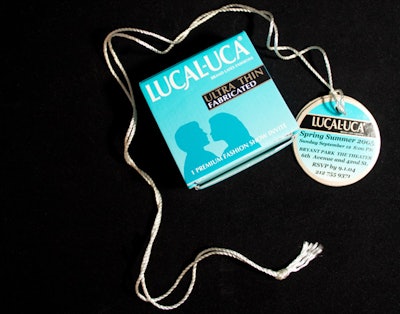
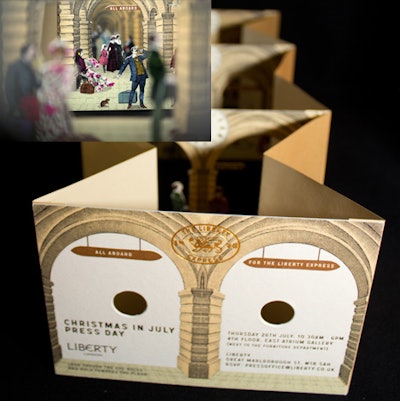
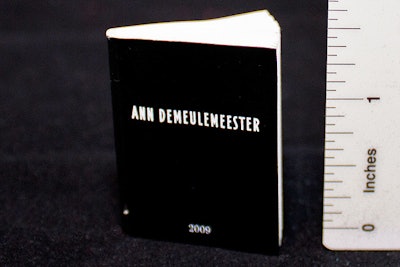
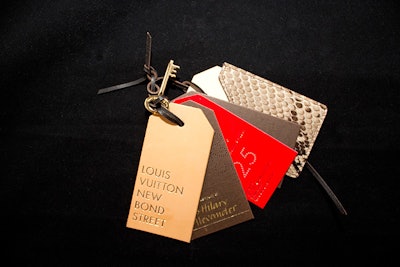
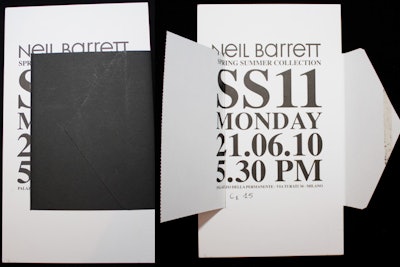
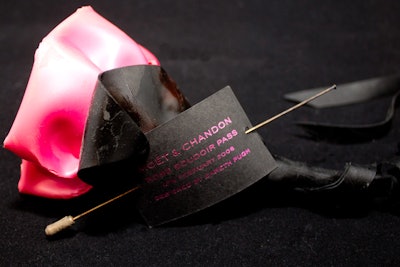

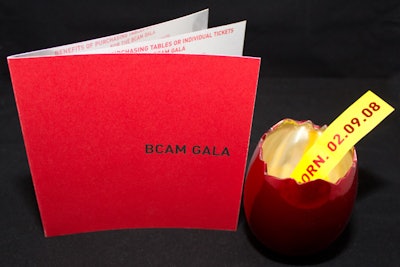
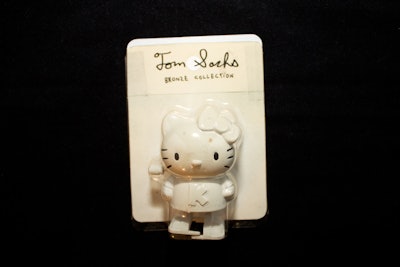
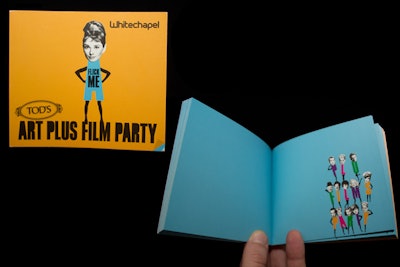
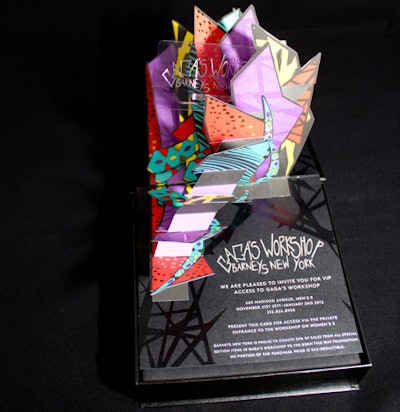
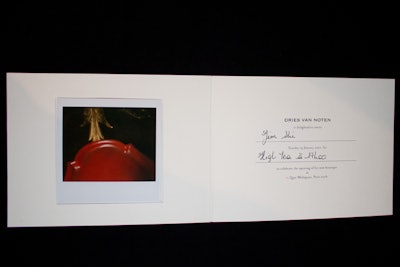
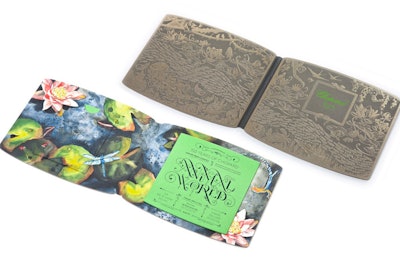
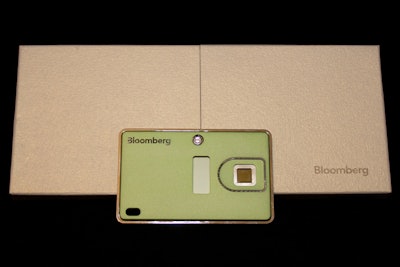
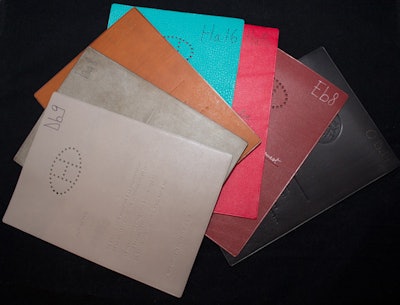
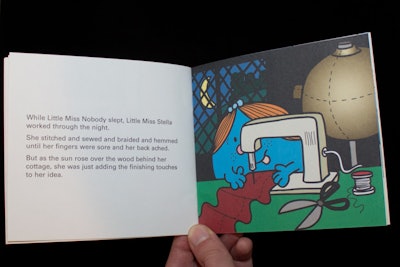
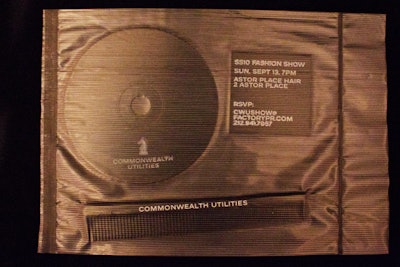
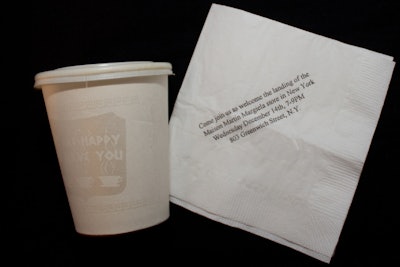
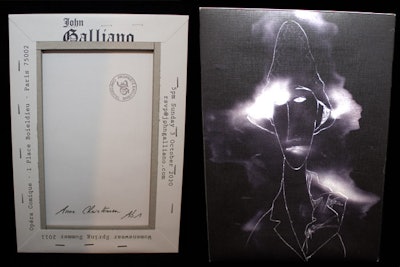
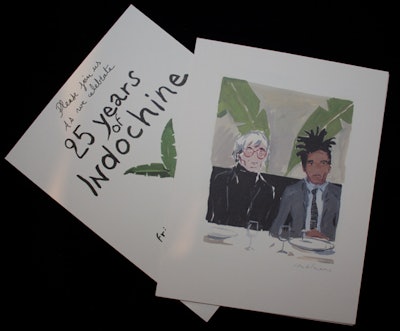
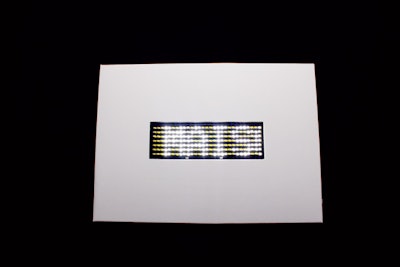
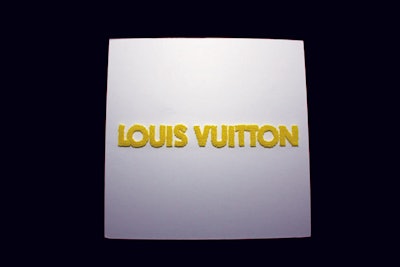
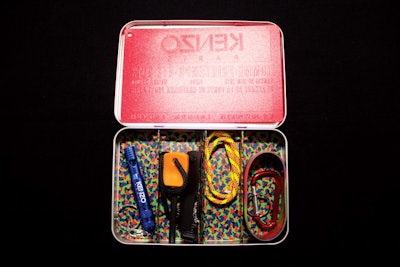
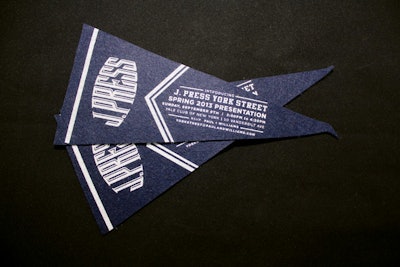
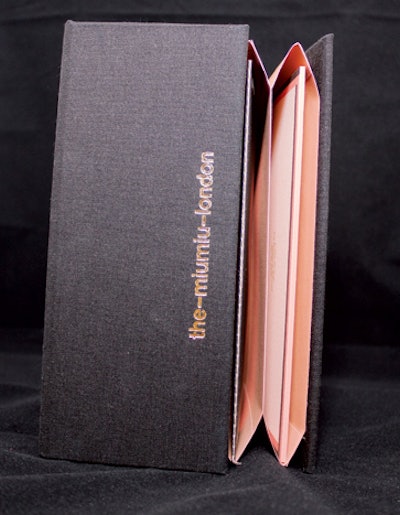
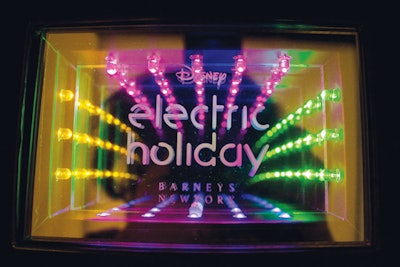
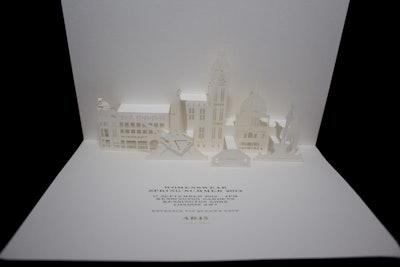
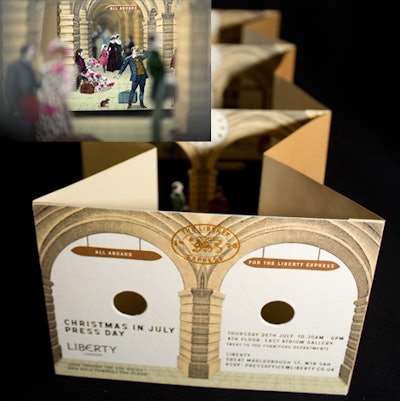
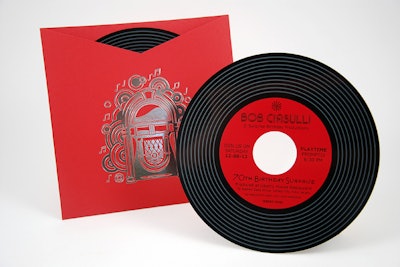
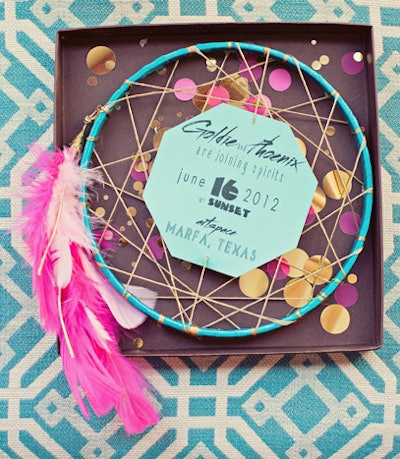
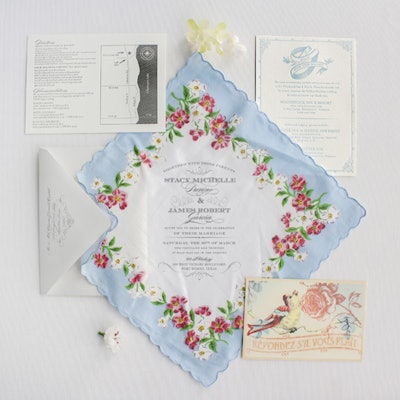

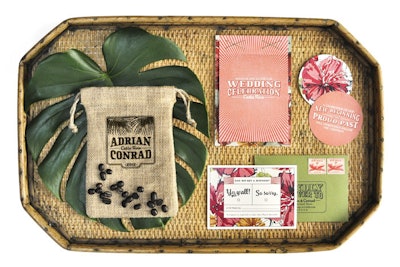
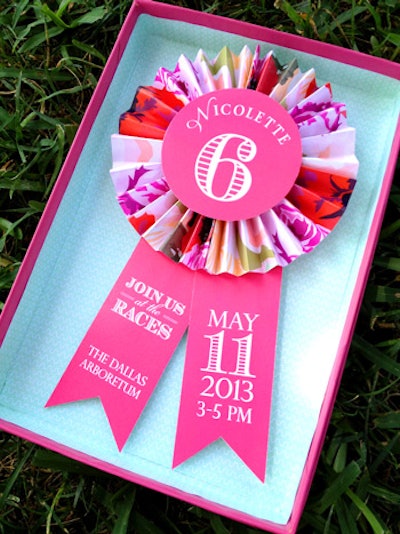
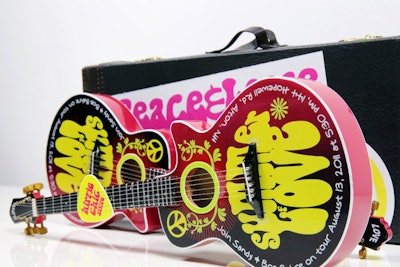
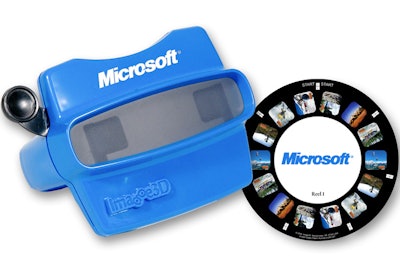
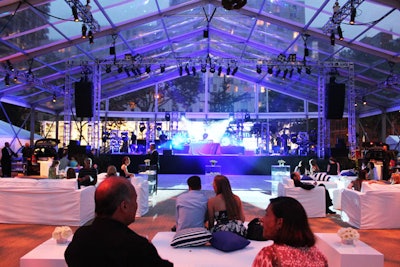
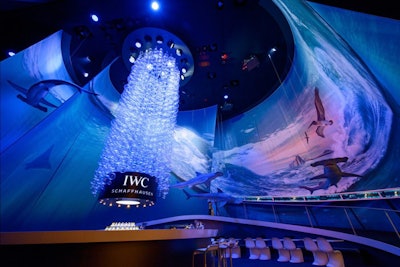
Known for creating the show's most visually stimulating booths, IWC Schaffhausen chose a water-theme setup this year, which celebrated its Aquatimer collection and was inspired by the Galapagos Islands, both above and beneath the water. Meant to evoke the feeling of diving into a wave, replica hammerhead sharks hung from the ceiling, surrounding a central chandelier comprising 2,400 individually strung Plexi "bubbles" that hung nearly 30 feet down. Two cross projectors cast deep sea images both vertically and horizontally onto two large curved screens, while a circular bar in the middle of the space housed an information desk and a bar that served cocktails and even caviar.
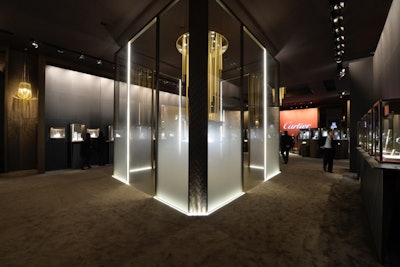
Showcasing more styles than any other brand at Salon International de la Haute Horlogerie, Cartier had a vast display space that allowed it the luxury to create multiple vignettes to present its designs—both archival and current. With dozens of timepiece and jewelry creations on display, the section was more like a museum than a straightforward showcase. The fully carpeted venue also boasted a small army of staffers and greeters on hand, as well as multiple lounge spaces.
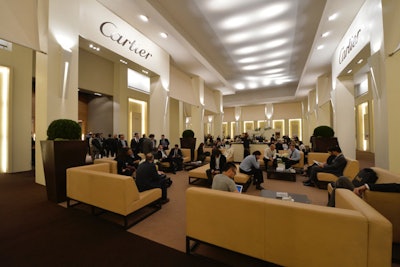
Unsurprisingly, given its global size and position as the top Richemont brand, Cartier was afforded its own wing at the show simply to be able to accommodate the sheer number of journalists and retailers in attendance. Central seating, coffee bars, and dining quarters remained consistent with the rest of the fair. In total, Cartier's booth occupied 21,528 square feet.
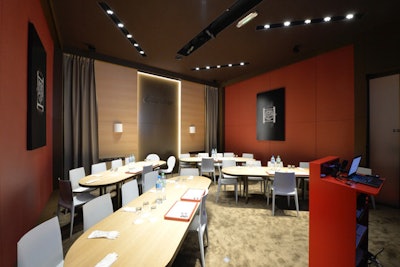
While each brand at the show had its own custom-created rooms to host group presentations, Cartier, due to its size and popularity, offered multiple such rooms. That included a space where journalists were presented the brand's latest timepiece offerings while a moderator explained the collections with a slideshow.
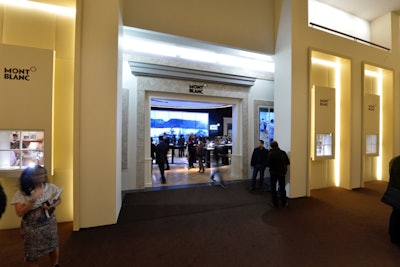
Montblanc created its own world of watchmaking as a booth within a booth, building a replica façade of its manufacture facility in Villeret, Switzerland. The concept was to exhibit the brand's passion for fine watchmaking by seemingly entering into one of its manufacturers. Custom windowpanes along the exterior featured stills of its Villeret watchmakers.
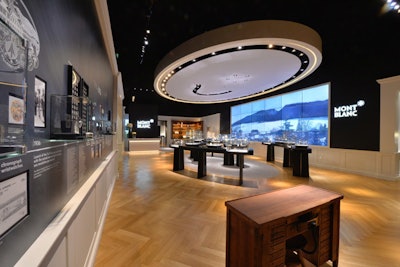
Inside the Montblanc booth, a large video wall showcased the Jura Valley that watch craftsmen see from their posts. Rounding out the space were hardwood floors, a library, a wall showcasing the brand's history, and curved table displays shaped like an arrow.
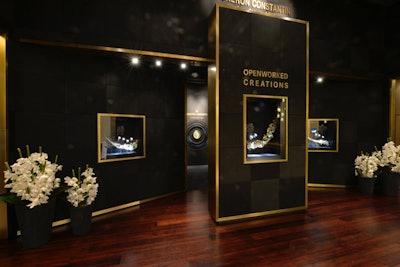
In Vacheron Constantin's section, skeleton timepieces, or openworked watches, were a major theme this year-—evident by the signage, complemented by lush orchids, that stood at the entrance.
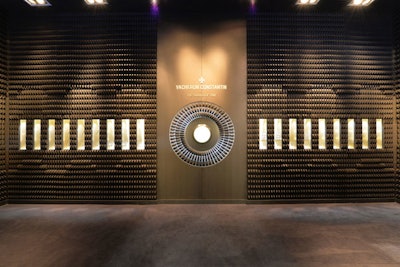
Beyond the initial entry, and housed along a textured and 3-D vault-like wall, was the "Sounds of Time" exhibit that featured an expansive historical collection of the brand's chiming watches on display and highlighted the new Caliber 1731, the thinnest minute repeater on the market today.
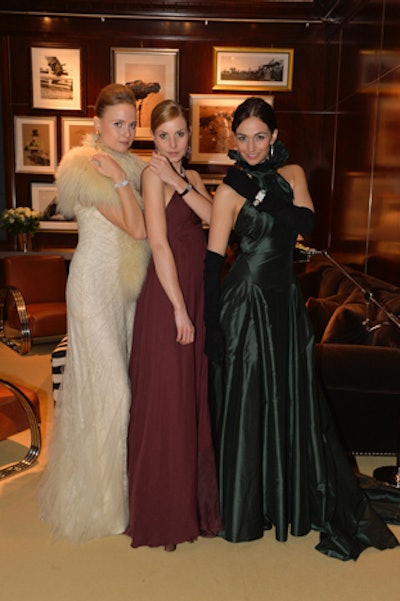
While last year's safari theme was driven home with the inclusion of Ralph Lauren's own 1950 Land Rover shipped to his booth, this year's emphasis on female-centric design offerings was complemented by a trio of models, all clad in Ralph Lauren Collection gowns, that modeled the brand's feminine creations and diamond fine jewelry.
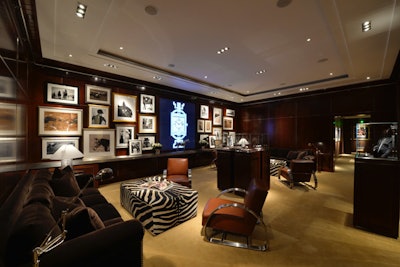
The lounge space inside the Ralph Lauren booth could easily have been taken from any of its grand flagship retail stores. More feminine-inspired, the decor continued the mix of sophistication and glamour, while portraits on the wall highlighted the designer's equestrian world.
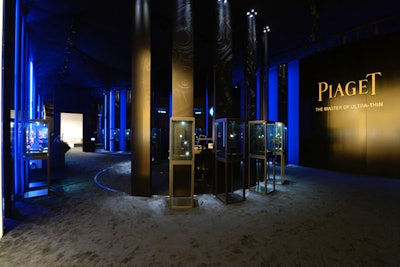
The darkest of all the SIHH brand booths, Piaget regaled in its status as the "Master of Ultra-Thin" with a new vertically theme space uplit and awash in blue. A flowing display of Piaget timepieces, including the new Altiplano 900P, lined the vitrines while similar showcases for ladies' timepieces off to the side were accented with Yves Piaget roses. The record-breaking watch collection was on display in the center of the booth, accompanied by a Piaget watchmaker who was working on the movement in real time. The individual slats throughout the space reinforced the brand's notion for all things thin.
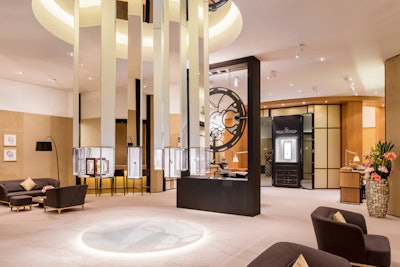
Inspired by the atmosphere and style of its boutiques, the Jaeger-LeCoultre booth was designed as a meeting point for collectors, guests, and connoisseurs. Warm and luminous, the classically elegant space featured low-lying sitting areas, a trio of craftsmen (watchmaker, engraver, and gem setter), and ample white space—all hidden behind an initial welcome wall. Many of its newest timepieces, including the Hybris Mechanica 11, were spotlit via a floating vitrine housed in the center of the space.
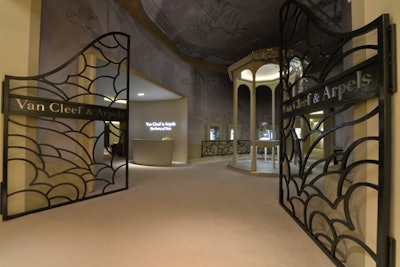
Van Cleef & Arpels channeled the celestial heavens for its booth. Guests entered through mythical gates and into the world of poetic astronomy, transported into the Maison's sources of inspiration: the planets and the constellation.
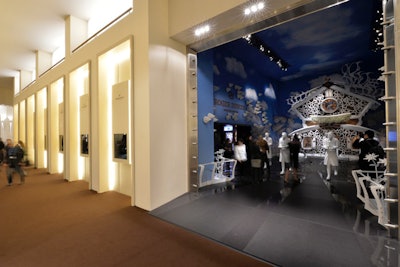
The Roger Dubuis section was symbolic of the brand's "love it or hate it" persona, and the brand was the only one to host an opening ceremony on the first day of the show for its booth. Inside, the replica life-size cuckoo clock, which weighed 1,764 pounds and stood more than 18 feet tall, was surrounded by a forest of 170 trees and 15 Edelweiss flowers made of 8,000 plastic and steel components. Five molds of vintage watchmakers held each of the new timepieces and rotated on the hour. Each element was hand-painted and set up took 920 hours, while production alone required 3,200 man-hours.
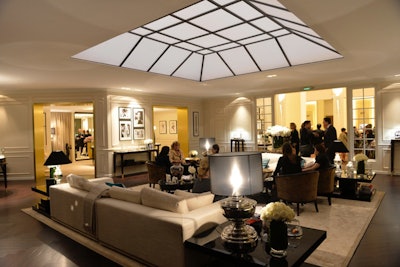
This year the theme for Baume & Mercier's booth was all about residential. From the entrance, designed like an entryway into a home (complete with the 1830 "house sign" that was a throwback to its founding year) to the furniture and floral displays, comfort and ease were the hallmarks of the concept.
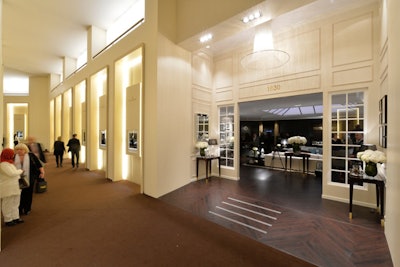
To achieve a cozy, familial feel, the brand built five rooms meant to mimic a family home and showcase the new brand logo and color palette of gold, brown, and cream. The foyer featured Baume & Mercier's history wall and the entertainment room hosted press, while the dining room and study showcased the women's and men's timepieces, respectively.
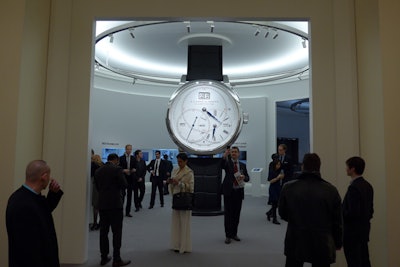
One of the fair's more stoic yet impactful booths, the section for German brand A. Lange & Sohne chose to put its newest creation front and center, as it had done in years past. The display focused its new Richard Lange Perpetual Calendar "Terraluna" timepiece with a giant version measuring about 16 feet in height and spanning 7.2 feet in diameter. To the right of the timepiece was a bar-lounge space and, directly behind it, a mini museum-like display showcasing the watch in development.
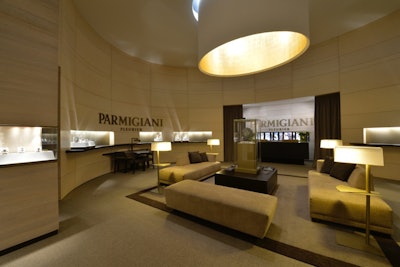
Parmigiani's booth evoked an elegant living room one would find inside an apartment in Milan. Muted tones and smooth surfaces created an uncluttered environment, while large glass vitrines displaying products marked the perimeter of the room. A central focus was a large light orb that cast a soft glow throughout the semicircular space.
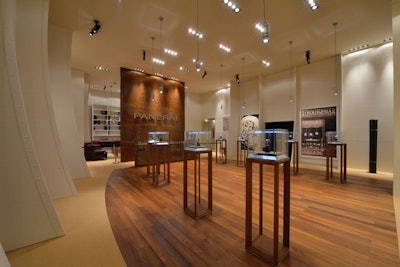
Panerai's thematic room focused on chronographs, which were showcased in its current selection alongside four new releases. To send the message home, the booth used imagery of sports to help express the brand's history and tell the story of the chronograph collection. Hence the steel side arches reminiscent of a submarine's hull, the galvanized steel panel on which the Panerai logo was placed, and the nautical-inspired library/lounge directly behind that featured a portal window in which a pocket watch was displayed.
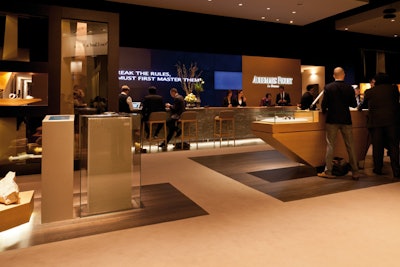
Audemars Piguet's booth was an extension of the themes incorporated into its new Bal Harbour, Florida, boutique that opened late last year. The concept of bringing the manufacture to the boutique was realized and crafted with wood and metallic landscapes evoking the Vallée de Joux region in Switzerland, the brand's birthplace. Divided into two spaces—“the Manufacture” and “the House"—the space offered guests the opportunity to both learn about the brand and see its modern accomplishments.
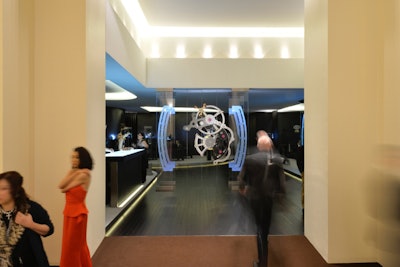
Technology and innovation have long been the hallmarks of Richard Mille, a brand favored by athletes like Rafael Nadal, so this year's booth, albeit somewhat futuristic with its slick surfaces and multilevel platforms, was kept simple and sparse to allow each watch's inner advancements to take center stage. Interestingly enough, Richard Mille was the only booth to ban photography of its timepieces altogether.
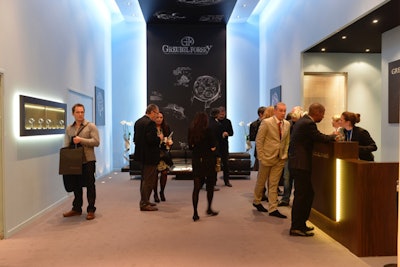
The smallest of the 16 exhibiting brands at 2,690 square feet, Greubel Forsey's booth sought to give its timepieces the space to speak for themselves. Within the exhibit there was a dedicated room for the "naissance d'une montre" (birth of a movement), a project launched in 2011 to preserve and pass on master watchmaking techniques.
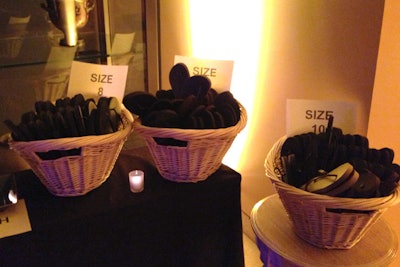
MSNBC also had a flip-flop station at its White House Correspondents' Association Dinner after-party, providing relief for folks who had been on their feet all evening.

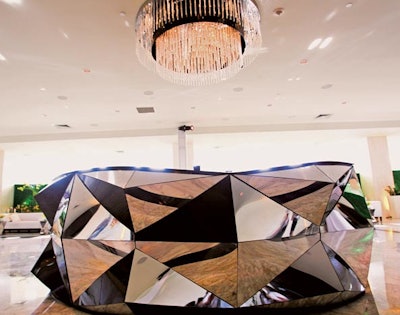
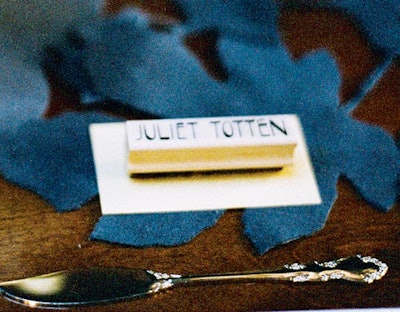
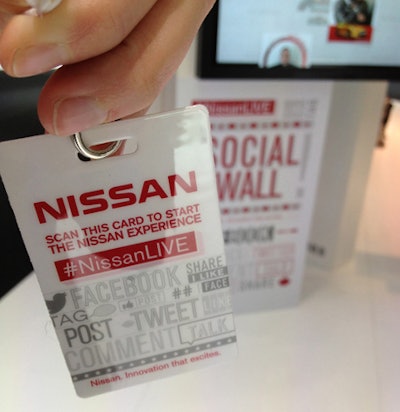
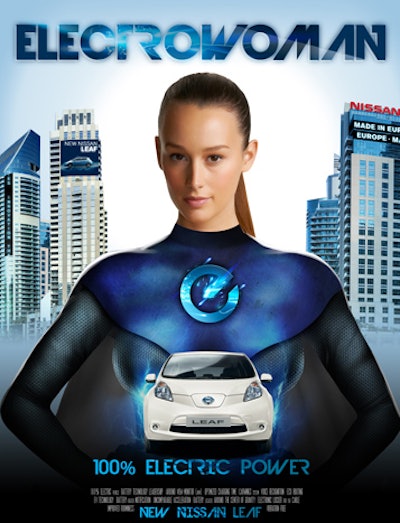
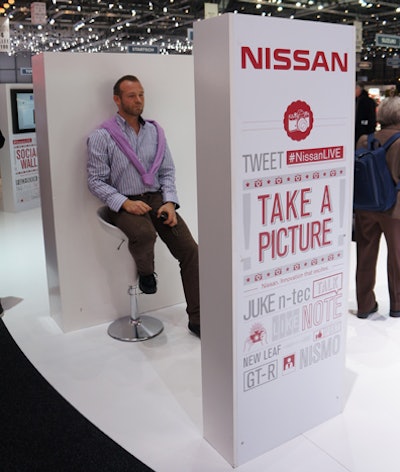
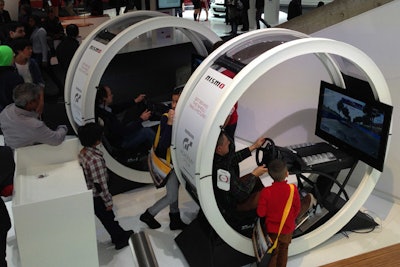
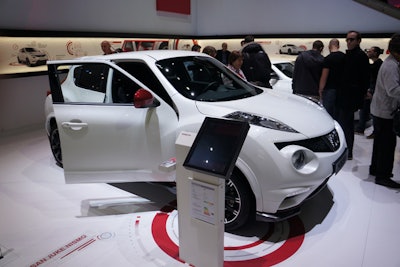
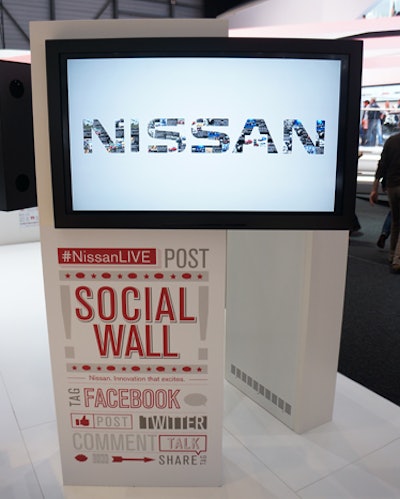
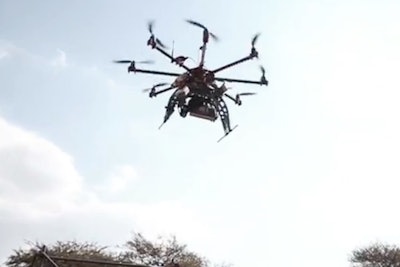
It sounds like something out of a sci-fi movie: a drone delivering beer to guests at a music festival. More than 150 guests at the OppiKoppi music festival in South Africa in August received free cold brews via drone. The initiative was a partnership of Darkwing Aerials, Windhoek Beer, and festival organizers. Guests ordered the beer using an app on their smartphones; staff received the orders and loaded parachute-equipped, single servings of beer (with a lid) onto the drone. Once in the air, the drone used the GPS coordinates of the phone that placed the order to navigate to its destination, where the single beer would drop and parachute down to the waiting recipient. The only area of the festival that was off limits for deliveries was the main stage, where the dense crowd made it too risky to drop beer from the sky. Darkwing Aerials owner Dean Engela said they intend to try the service at future events, using more than one drone to serve guests.
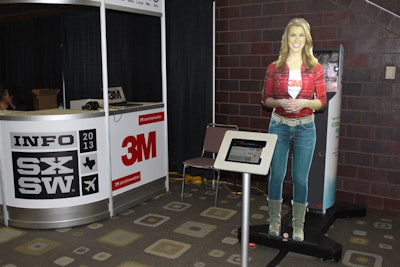
At South by Southwest Interactive in March, 3M wowed guests with a holographic virtual presenter. “Jenny” could sense people passing by and would speak and gesture to them, offering information about panels and events and inviting them to interact with an iPad displayed in front of her.
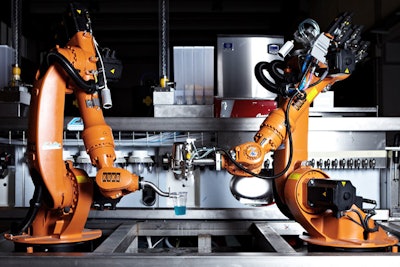
The Makr Shakr is a bartender, social sharing system, and alcohol consumption monitor in one robotic design. Designed by the M.I.T. Senseable City Lab in collaboration with the Coca-Cola Company and Bacardi Rums and produced by Italian firm Carlo Ratti Associati, the robot debuted at the Google I/O conference in May. Guests transmit their cocktail orders via the Makr Shakr app, then watch as three large, orange robotic arms mix up the prescribed combination of liquor, syrups, fruit mixers, and ice. The movements are precise enough to muddle a mojito and thinly slice a lemon. A large screen behind the bar displays a variety of stats, such as number of drinks in the queue, approximate wait time, drinks ready for pickup, and most popular spirits by gender. The app also allows users to see what type of drinks others are ordering, rate the drinks, and share photos on social networks. It also aims to promote responsible consumption by monitoring what a person orders and how often. The developers say for now Makr Shakr is a prototype, intended to be a “social experiment that looks at how people might embrace the new possibilities offered by digital manufacturing.”
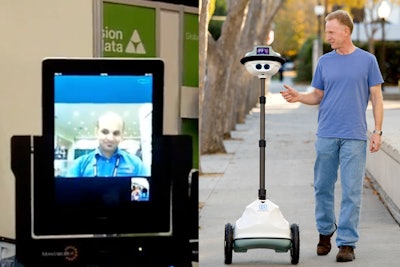
New systems allow users to participate in meetings and events from afar. MantaroBots TeleMe (left) uses an Apple device or Android tablet mounted on a tall, rolling base. Users connect to it using Skype or another video conferencing application and then control its movement from their desktop. “You have a screen, camera, microphone, and speakers in that nice square that emulates the head. And you can pan and tilt the tablet so you can look directly at people without turning the whole robot,” said Jeremy Parsons, C.E.O. at Mantaro Product Development Services. Anybots QB robot (right) uses an integrated screen, camera, and speaker atop a mobile platform that can be positioned from two and a half to six and a half feet off the ground. Users control and activate the robot using Anybots’ Web-based communications system. The company is developing a new model, the Qx, that will have a larger screen and be available in early 2014. At trade shows, these robots can allow someone off site to engage with visitors in a booth and to virtually explore the show floor. Both systems are equipped with obstacle-detection sensors and laser-pointer devices.
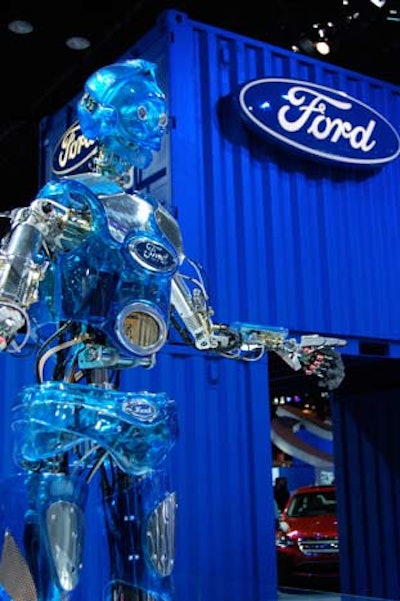
Ford Motor Company has brought its robot, Hank, to several auto shows over the past few years to greet and entertain consumers. The robot is controlled by a staffer hidden from view wearing sensors that transmit his movements to the robot. The staffer also has a microphone to carry on conversations with passersby via the robot.
